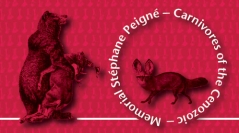

 Geodiversitas
42 (17) - Pages 257-304
Geodiversitas
42 (17) - Pages 257-304Cats possess some of the highest ankle gear ratios of any extant carnivorans, a feature that facilitates leaping and sprinting involved in ambush predation and scansorial lifestyles. In today’s North American carnivoran communities, the high gear ratio of cats contributes to an overall high ecometric average for this trait and contributes strongly to measures of ecometric disparity at the community level. But cats were late additions to North American communities, arriving from Eurasia about 17 Ma at the end of the “cat gap”. This paper uses ecometric analysis to document changes in hindlimb functional diversity in North American carnivoran communities over the last 19 million years in order to better understand the roles of trait evolution, clade turnover, and environmental change in community assembly. To accomplish this, I look at the phylogenetic history of ankle gear ratios of cats and other carnivorans, and the history of their occupation of high gear ratio niches in North American communities. The primary focus is on the Great Plains, which experienced profound changes in vegetation and climate through this period. Across all Carnivoramorpha, including a variety of extinct clades, it was found that gear ratios range from 1.08 (with extant ursids and viverrids and extinct miacids and barbourofelids, one of the three cat groups considered in this paper, having the lowest values) to 1.46 (with extant felids, herpestids, and canids having the highest values). Using the fossil record combined with phylogenetic ancestor reconstruction, it is shown that stem carnivorans and early felids had gear ratios about halfway between these extremes, consistent with a semidigitigrade or mildly digitigrade stance that was not overly specialized for either leaping or sprinting. Barbourofelids and some machairodontines evolved lower gear ratios that emphasized mechanical efficiency over advantage. When cats first entered North American communities in the Miocene they did not occupy high gear ratio niches and, in fact, occupied some of the lowest gear ratio niches during the Barstovian, Clarendonian, and Hemphillian. A major restructuring of gear ratio distributions in North American carnivoran communities occurred during the Blancan that appears to have resulted from clade sorting processes involving the selective loss of low gear ratio groups, as well as the evolution of increased gear ratios in felids and canids.
Carnivora, Felidae, ecometrics, functional trait ecology, locomotor morphology